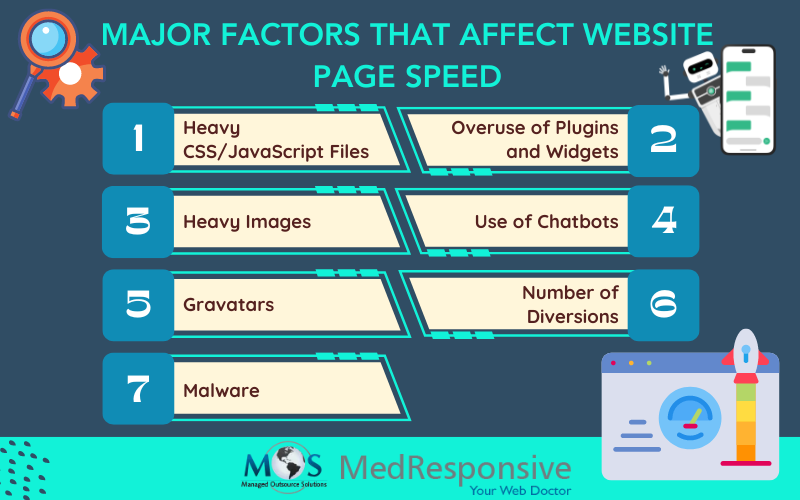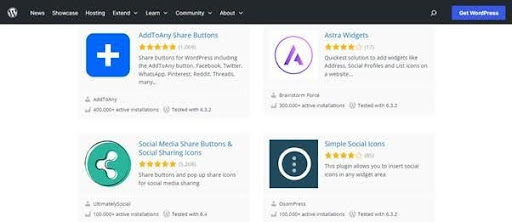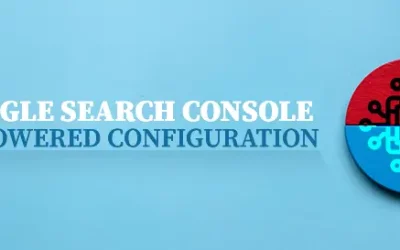In digital marketing, web page speed or page load time is a major consideration when it comes to attracting and retaining visitors. A slow website increases bounce rate, kills conversions, and impacts search rankings. Page speed impacts how long your visitors stay on your site, how many of those visitors convert into paying customers, how much you pay on a CPC basis in paid search, and where you rank in organic search. Even low mobile page speed affects web traffic and search engine optimization. An experienced provider of digital marketing services will make sure that your website pages won’t take too long to load.
According to Search Engine Watch, you should pay attention if your site is taking more than three seconds to load. This means it’s time to figure out what exactly is slowing down your website speed and how improve its overall performance.
Major Factors That Affect Website Page Speed
What is Page Speed?
Page load speed is essentially the amount of time it takes for a page on your website to load. It refers to the overall speed of your website. The loading speed of a page is determined by several factors. Here are the common page speed metrics:
- Time to first byte (TTFB): This refers to how long it takes for your page’s very first byte of data to load. Generally speaking, it’s a reliable indicator of how quickly the server loads.
- Time to interactive (TTI): TTI examines how long it takes for the interactive features on a page to load. This is a useful method for determining whether javascript is slowing down your website.
- First contentful paint (FCP): This expression describes how long it takes for your website’s first piece of content to load. It could be an SVG file, text, or an image, even a backdrop image.
- Load time: This is the time it takes for a page and all of its components to fully load is called the load time.
- Mobile first: Although it’s not technically a page speed measurement, mobile first is a crucial factor in determining how long it takes for your website to load. This implies that the tool is evaluating your website’s speed based on its mobile version rather than its desktop version. Speed becomes much more important while utilizing a mobile device, but unfortunately, the fundamentals of page speed optimization are sometimes neglected.
Here are some statistics on Page Speed listed in an article by WebFX:
- On mobile devices, the typical website loads in 8.6 seconds.
- The average time for a page to load on a Google page one ranking is 1.65 seconds.
- 83% of internet users demand that webpages load in three seconds or less.
- If a website takes more than three seconds to load, 40% of internet users will leave.
- The average bounce rate for sites that load in less than a second or two is 9%, but the average bounce rate for pages that load in five seconds or more is 38%.
Why It Is Important to Improve Web Page Speed
- Enhances user experience
- Reduces bounce rates
- Improves SEO rankings
- Leads to higher conversion rates
- Contributes to user retention
- Improves crawlability
- Provides global accessibility
- Boosts social media performance
What is a good website load speed? The majority of individuals would agree that it is two seconds or less. However, the answer to this question really depends on the kind of page you have and how you’re evaluating page speed. It’s important to keep in mind that users can access and utilize your website without necessarily waiting for the entire page to load. Sometimes, what matters most is the time it takes for the first content to load (FCP) or the time it takes to become interactive (TTI). An average page speed isn’t likely to be a fair benchmark because in reality, there’s so much variance in page loading times across different websites. However, it is important to know the key factors that can affect your site’s page speed.
What Affects Your Site’s Page Speed?
- Heavy CSS/JavaScript Files: Cache issues of the browser could be one key factor impacting page speed. CSS and JavaScript files as well as images that add functionality to the site’s front end will get stored in the user’s browser when the user visits the site for the first time. When the visitor comes back to the page, browser cache allows these stored files to be served quickly. A solid caching strategy helps to maintain strong user experience. Setting up caching properly helps avoid user interruption. For those not using WordPress, Cache-Control and Entity tags (ETags) headers to HTTP response headers can help visitors avoid downloading the same files from the server twice and reducing the number of HTTP requests. ETag HTTP response header –
- allows caches to be more efficient and save bandwidth
- helps prevent simultaneous updates of a resource from overwriting each other
For WordPress sites, cache plugins offer better performance. Several caching plugins are available to help WordPress work more efficiently and thus improve the website speed. This plugin will create a static version of the content and remove many of the steps that take place when a page is generated dynamically, resulting in faster loading times and happier visitors. Some such plugins are W3 Total Cache, WP Rocket, WP Super Cache, Hyper Cache and WP Fastest Cache. Of these, WP Rocket is a premium cache plugin that comes with extra features such as lazy loading, database clean-up, CDN integrations, and many more. This plugin reduces the weight of your HTML, JavaScript and CSS files through minification. WP Rocket is also one of the easiest ways to schedule and clean up overloaded database files every week.
Make sure to analyze your website using PageSpeed Insights. You can also implement your own content delivery network (CDN) to ensure visitors around the world have a much more accessible, fast experience.
- Overuse of Plugins and Widgets: Attractive widgets and plugins used on your website to offer the audience more features can actually reduce the website speed. Each plugin you add requires resources to run the site. Too many plugins can also cause security issues.
Image Source
Consider removing unnecessary plugins, as the more plugins and widgets you use on your site, the more time it takes to load all the required files. In such cases, always try to use recently updated quality plugins that come from reputable resources. In Drupal or Joomla, users can disable modules or add speed optimization extensions.
- Instead of social sharing plugins, consider embedding social media buttons into the source code.
- Avoid plugins that load a lot of scripts and a lot of styles.
- Heavy Images: Web pages with more complex images could lower conversion rates compared to those with fewer images. Images of large size and high-resolution and those that are uncompressed can significantly reduce the page load speed. Flash images and content can also slow down your pages. HTML5 provides alternatives to replace your existing Flash content.
During the web design stage itself, decide on an optimal width and height for image display on different end-user devices like desktop, laptop, tablet and smartphone. Also, use standard formats like JPEG, GIF, and PNG that can compress images to take up a lesser number of bytes, thus reducing the size of the file. You can also consider new image formats like WebP and JPeg XR to reduce image weight without sacrificing image quality.Hotlinking or images on your website that are hosted on a different server can also delay your page from loading. This means that some other site is using your server responses. This could slow down your server and trigger suspension of your hosting account. You can use .htaccess file to prevent hotlinking to websites.
- Use of Chatbots: Most websites today have some kind of live chat or instant messaging option or pop-up chat once you enter the site. These chatbots are used for handling customer queries, instead of appointing real persons.However, chatbots can directly or indirectly affect many factors such as website speed, site usability, user reviews/site reputation, bounce rate or dwell time that can impact a website’s performance and position in SERP. The chatbot script should be well implemented. To make the chatbot load asynchronously, make sure to use the correct code which enables this action.
Image Source
Diverse tools are now available to check your website’s speed performance, such as Pingdom Tools, GTmetrix, or Google’s own PageSpeed Tools. These tools can detect if there is a problem with a chatbot script and if it is causing a website to load more slowly. Google PageSpeed Insights examines the entire site and lists every issue affecting its loading speed. External servers can also be used to handle the working of the site’s chatbot.
Image Source
- Gravatars: Gravatar refers to “globally recognized avatar and this allows platforms like WordPress and other web applications to display user profile photos. By default, WordPress uses Gravatar for displaying profile images and comments. With Gravatar, whenever you create a new account on a website you don’t have to upload a photo each time. But it can affect web page speed. Each time a visitor’s browser will have to load all of the associated Gravatar images from Gravatar’s external servers.
- To help speed up Gravatar delivery, you can consider caching Gravatar images using plugins like FV Gravatar Cache.
Looking to earn more links?
Read our blog:
The Most Common Link Building Mistakes
Other options to improve web page speed are –
- Disable Gravatars in WordPress site
- Remove comments that are of no value
- Reduce Gravatar image sizes
- Number of Diversions: Redirections are a common tool used by web designers to make their pages accessible from many URLs. While employing these redirections can improve website traffic, you must utilize them carefully. Your website’s speed is impacted when there are pointless redirections since they take longer to load. You can find, evaluate, and eliminate superfluous redirections using a variety of tools, like Redirect Mapper Tools.
- Malware: Malware puts a lot of strain on your server. This slows down website loading and performance, even causing the website to crash in extreme situations. To avoid virus infiltration, it is advisable to get plugins and themes from reliable sources. Malware scanners can assist you in locating these flaws so you can take appropriate action.
Other factors that can affect your site’s speed are – broken links, outdated CMS version, overloaded database and more.
Maximize your ROI with data-driven digital marketing.
It is crucial to continuously monitor and test your website’s speed using tools like Google PageSpeed Insights, GTmetrix, and WebPageTest. Regular testing can help identify performance issues and improvements. An experienced provider of digital marketing services can help optimize your site’s speed and improve its overall performance.








